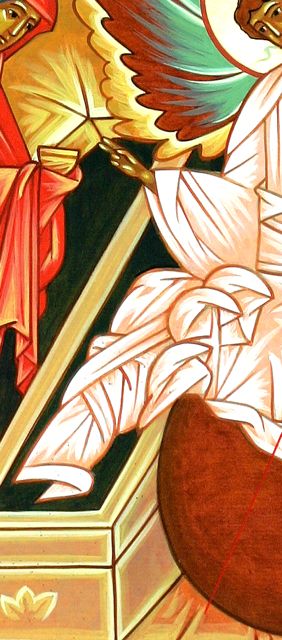
The empty coffin in the Easter icon of the Myrrh-bearing Women holds in its center, this coffin from which Jesus has emerged to be and bring life to the world. I love the way the white vestments of the angel and the white linens of the tomb are indistinguishable. They are one piece of cloth to the iconographer.
Where do the bandages we use to wrap our wounds and the cloth of the angels begin and end? It reminds me of the passages in our scriptures in which angels minister to Jesus (i.e.: after the temptations in the desert and just prior to His baptism.) It also reminds me of the mother whose own shawl wraps both her shoulders and her child. Imagine if Jesus’ first sight in awakening from the trauma of Holy Week was to see an angel and then to feel the warmth of a shroud in a cold cave and then to notice that his shroud was part of the angel’s vestments.
Our vestments in church tend to be designed to impress. They are modeled on the cloaks of royalty and they shimmer with gold and velvets. But what if they were simpler and doubled not so much as drapes of glory but more as blankets of warmth for the people who have come into the church from the cold winds of reality in daily life?
Jesus was, at least for a time, entombed in a cave and perhaps in a sarcophagus from which He was released to bring life to the world. In what cold hard, sarcophagi are we imprisoned and what warm, soft, thick, white, clean bolts of gentle angel-linen are working their way into our lives by God’s grace?
It is one thing to feel a blanket wrapped around you. It is quite another to begin to realize that it extends up and around an angel who sits in vigil, a witness to your release. It is for that reason, that I consider friendship to be a sacrament and perhaps, the greatest sacrament of all.

